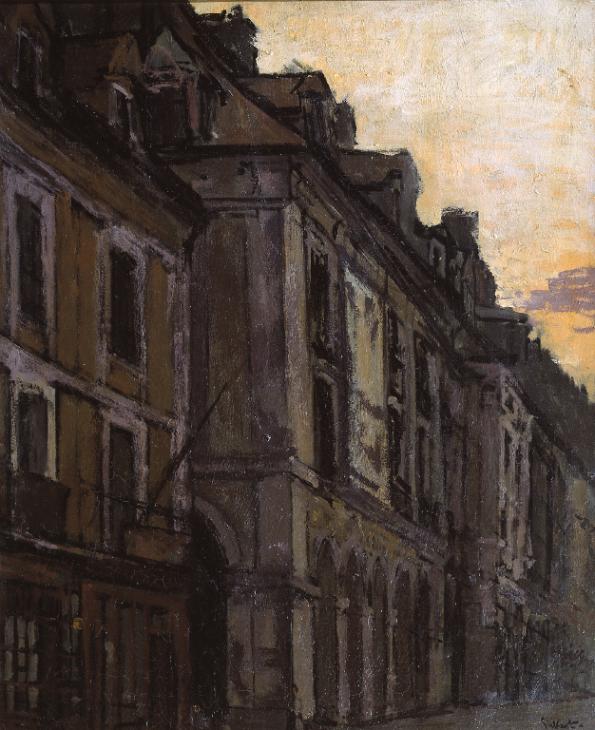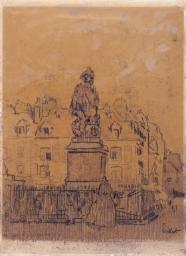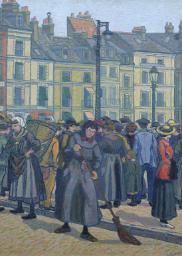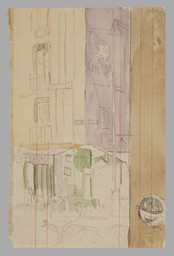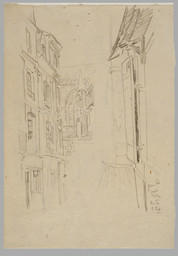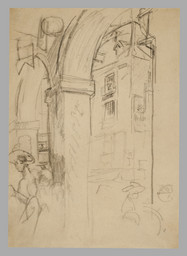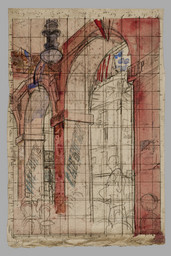Walter Richard Sickert Les Arcades de la Poissonnerie, Dieppe c.1900
Walter Richard Sickert,
Les Arcades de la Poissonnerie, Dieppe
c.1900
Walter Sickert had a lifelong relationship with the Anglo–French resort town of Dieppe, of which he made numerous pictures and where he also lived from 1898–1905. This steep receding view is dominated by the façades lining the boulevard Quai Duquesne, which are periodically punctuated by dark arcades. The grey ground and shaded tones are broken only by the sky in the upper right corner of the painting, reflecting the setting sun. Running along the western edge of the harbour, the street was known as ‘Arcades de la Poissonnerie’ because of its proximity to the fish market.
Walter Richard Sickert 1860–1942
Les Arcades de la Poissonnerie, Dieppe
c.1900
Oil paint on canvas
612 x 502 mm
Inscribed by the artist ‘Sickert’ in black paint bottom right
Presented by the Contemporary Art Society 1939
N05045
c.1900
Oil paint on canvas
612 x 502 mm
Inscribed by the artist ‘Sickert’ in black paint bottom right
Presented by the Contemporary Art Society 1939
N05045
Ownership history
Presented by Lord Howard de Walden to the Contemporary Art Society 1928; presented to Tate Gallery 1939.
Exhibition history
1900
?Walter Sickert, Durand-Ruel Gallery, Paris, December 1900 (40).
1919
?Walter Sickert, Eldar Gallery, London, January–February 1919.
1960
Sickert: Paintings and Drawings, (Arts Council tour), Tate Gallery, London, May–June 1960, Southampton Art Gallery, July 1960, Bradford City Art Gallery, July–August 1960 (49).
1968
Fifth Adelaide Festival of Arts: Walter Sickert, Art Gallery of South Australia, Adelaide 1968 (14).
1989–90
W.R. Sickert: Drawings and Paintings 1890–1942, Tate Gallery, Liverpool, March 1989–February 1990, Tate Gallery, London, July–September 1990 (18, reproduced).
1992
The Dieppe Connection: The Town and its Artists from Turner to Braque, Brighton Museum and Art Gallery, May–June 1992 (71, reproduced).
References
1929
Contemporary Art Society Report 1928, London 1929, p.11, as Street.
1940
Contemporary Art Society Report 1938–9, London 1940, p.12, as View of a Street.
1960
Lillian Browse, Sickert, London 1960, p.101, as Down the Arcades de la Poissonnerie, Dieppe.
1964
Mary Chamot, Dennis Farr and Martin Butlin, Tate Gallery Catalogues: The Modern British Paintings, Drawings and Sculpture, vol.2, London 1964, p.627.
1973
Wendy Baron, Sickert, London and New York 1973, no.123, p.323.
2006
Wendy Baron, Sickert: Paintings and Drawings, New Haven and London 2006, no.138.1, p.247.
Technique and condition
Les Arcades de la Poissonnerie, Dieppe is painted on a pre-primed fine linen canvas attached to a five-member strainer that was probably purchased from a Dieppe colourman (see Tate N05313). The number twelve has been stamped onto the back of the canvas, indicating that the canvas was a standard commercial size (see Tate N03182). A grey-green layer has been applied onto the white ground, probably by the artist, to act as an optical ground. The main compositional lines were drawn in black paint directly onto this layer and subdued tones were then brushed over the lines to build up the tonal composition and break up linear form. The paint appears to be of a tube consistency and is applied relatively thickly, forming isolated drying cracks in the browns and olives where there is a greater build-up of paint and/or a higher concentration of medium. Strong brushwork that does not correspond with the final image is visible at the surface indicating that the artist made various modifications during painting, and some less important areas of the work remain unresolved, the bottom right-hand corner, for example. However, the painting is varnished and signed by the artist suggesting that he considered the work finished.
Stephen Hackney
June 2006
How to cite
Stephen Hackney, 'Technique and Condition', June 2006, in Nicola Moorby, ‘Les Arcades de la Poissonnerie, Dieppe c.1900 by Walter Richard Sickert’, catalogue entry, September 2009, in Helena Bonett, Ysanne Holt, Jennifer Mundy (eds.), The Camden Town Group in Context, Tate Research Publication, May 2012, https://wwwEntry
The subject of this painting is part of the Quai Duquesne, a boulevard in Dieppe which runs along the side of the Bassin Duquesne on the western edge of the harbour. Sickert’s view shows the street from an oblique angle so that the picture plane is dominated by the dark imposing line of arcaded frontages until it is relieved by the light and colour of the sunset sky in the top right-hand corner. The building in the centre of the composition is one which stood near the old Customs House, in between the Rue Notre Dame (the first street opening on the left) and the Rue Saint-Jean (second left). Owing to its proximity to the fish market at the end of the quay it was known as the Arcades de la Poissonnerie. A near contemporary photograph shows that during the early twentieth century it comprised a series of small shops, cafés and hotels,1 while Sickert’s etching, Dieppe, La Rue Notre Dame 1909,2 reveals that the first arch nearest to the viewer housed the ‘Café Marine’.
Sickert had a long-standing connection with Dieppe dating back to childhood holidays with his family. For over thirty years he spent nearly every summer there, and between 1898 and 1905 he also made it his permanent home. Along with Venice and London, it was the place which provided the greatest and most consistent source of inspiration for his art. He roamed freely around Dieppe painting landscapes which provide an extensive visual record of the key sights and landmarks, streets and markets, harbour and quays, the seafront and the fishermen’s quarter of Le Pollet (see, for example, Tate N03182). As was his wont, certain subjects came to exercise a particular fascination for him and he revisited them repeatedly, making numerous variations upon a chosen motif, such as the statue of Admiral Duquesne in the Place Nationale (see Tate N05096), or the Gothic façade of the church of St Jacques (see Tate N05094). Les Arcades de la Poissonnerie is just one of a large number of paintings and sketches dating from his seven-year residency which documents the Quai Duquesne,3 while a popular related theme was the view looking down the Rue Notre Dame towards the cupola and tower of St Jacques, which featured the same two buildings on the immediate left and centre of this painting.4 A personal reason for his focus on this part of town may have been that the Arcades de la Poissonnerie was also the address of his Dieppoise mistress, Augustine (Titine) Villain, a local woman who ran a stall in the fish market.5
It was Sickert’s accumulated repertory of views which led the French painter, Jacques-Emile Blanche (see Tate N04912), to describe Sickert as ‘the Canaletto’ of Dieppe, adding ‘No other artist has so perfectly felt and expressed the character of the town’.6 His topographical approach was simultaneously that of an outsider and a local inhabitant. On the one hand he focused on picturesque tourist attractions such as the traditional architecture, the cafés, the hotels and the casino. On the other, however, his treatment of the subject matter created an unglamorous, everyday familiarity which suited the waning heyday of the once fashionable Anglo–French resort. Despite being a depiction of one of the liveliest parts of town, Les Arcades de la Poissonnerie has a melancholy atmosphere effected by the claustrophobic pictorial space, black lines, sombre palette and grey ground. The steep receding viewpoint is similar to that used in other townscapes such as South Façade of St Jacques: The Rag Fair c.1898 (private collection),7 and Rowlandson House – Sunset 1910–11 (Tate N05088), and the artist seems to have been absorbed by the structural rhythm and geometric forms of the buildings, and the interplay between the light stone façade and the dark spaces of the arcades. In common with other Dieppe subjects from the time, the painting demonstrates Sickert’s technical progress towards a freer and more fluid application of paint and the prominent use of sketchy dark structural outlines as an integral part of his practice.
Tate’s painting is virtually identical to another contemporaneous version of the subject, Les Arcades de la Poissonnerie c.1900 (Pallant House Gallery, Chichester),8 and there is also a related drawing of the same view.9 Furthermore, Sickert used the composition as the basis for a new treatment of the subject many years later, probably during the mid-1920s.10 This rendering of Arcades de la Poissonnerie employs heavy outlines with a bleached, bichromatic palette and is one of a number of Dieppe subjects revisited by the artist at this time.
Nicola Moorby
September 2009
Notes
See image on http://www.quiquengrogne-dieppe.com/2009/04/les-arcades-dieppe.html , accessed August 2009. See also a watercolour by Walter Taylor, Les Arcades de la Poissonnerie 1911 (Brighton and Hove Museums), reproduced at http://www.virtualmuseum.info/art/qz_20th/taylor_w.asp , accessed August 2009, and Charles Ginner, La Vieille Balayeuse, Dieppe 1913 (Tate T13025).
Reproduced in Ruth Bromberg, Walter Sickert Prints: A Catalogue Raisonné, New Haven and London 2000, no.134.
See, for example, La Rue Notre Dame and the Quai Duquesne c.1899 (Ashmolean Museum, Oxford) and related pictures; reproduced in Baron 2006, nos.126–126.21.
Jacques-Émile Blanche, Portraits of a Lifetime, trans. and ed. by Walter Clement, London 1937, p.45.
Ibid., no.138.5; reproduced in 20th Century British Art, Bonhams, London, 30 November 2004 (lot 16).
Related biographies
Related catalogue entries
Related archive items
How to cite
Nicola Moorby, ‘Les Arcades de la Poissonnerie, Dieppe c.1900 by Walter Richard Sickert’, catalogue entry, September 2009, in Helena Bonett, Ysanne Holt, Jennifer Mundy (eds.), The Camden Town Group in Context, Tate Research Publication, May 2012, https://www

